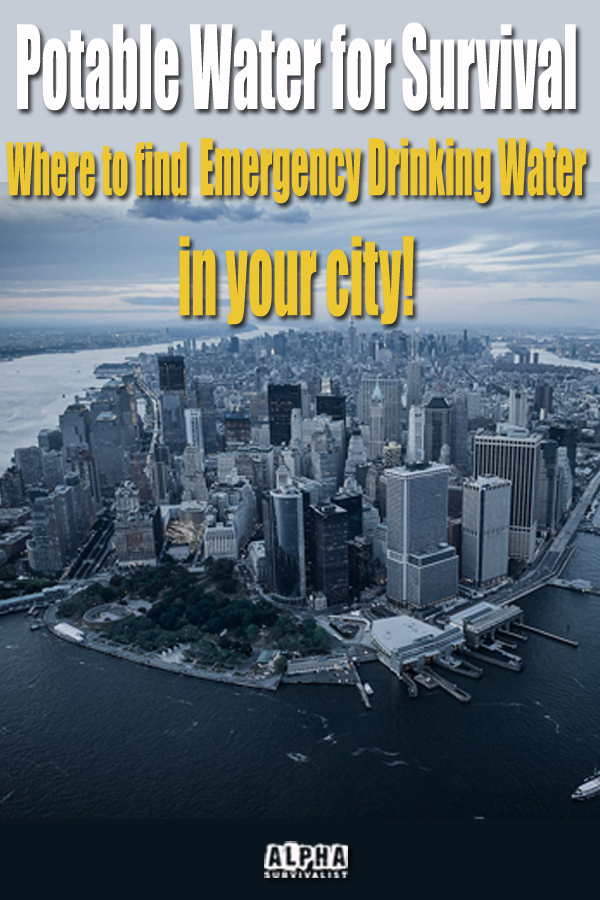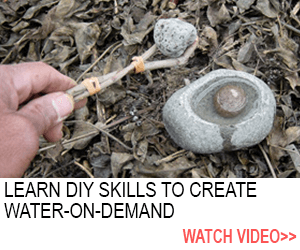
Without clean drinking water, a death from dehydration, or from disease caused by drinking contaminated water, will be the most probable outcome. To make matters worse, if you’re situated in a hot climate and your exertion levels are high you can forget about lasting a week; you’ll be lucky to make it beyond THREE days!
Not a pleasant thought is it? Yet the daily fight for clean drinking water is one that many people around the world face.
When you consider that 71% of the world’s surface area is water; it’s pretty hard to get your head around the fact that thousands of men, women, and children, die daily from a lack of clean drinking water.
It is true however; as I’m sure you’re aware, the vast majority of people who die from thirst or from water borne diseases live in under-developed countries. Countries without adequate resources and poor infrastructure, but that isn’t to say that the lack of clean drinking water is a problem you will never have to contend with!
There have been numerous cases when natural disasters or wars have caused localized water shortages or contamination in developed countries and they happen all too frequently.
More often than not it is those who live in highly populated environments, cities and towns, who are most at risk of having a major problem with their water supply. So, if you are in the 63% of Americans who can be classed as ‘urbanites’ then this article should be of particular interest to you!
Preparation is Key!
Obviously, the best way to counter any breakdown in your clean water supply is to make sure you have safely stored enough water to see you through any crisis, which is why water storage is almost always one of the first things that any prepper or survivalist will look to tick off their emergency list.
Once you have taken care of your water storage, you then need to look at methods of water filtration and purification. Your stash of water will not last forever and may even be inaccessible from the start of the crisis, so you will need to know how to purify water and use survival water filter methods so you can drink any water you find safely.
Setting the Scene
Although we cannot stress enough the importance of having water stored safely away for any emergency situation, this article will work within the following scenario.
- You live in an apartment in a sprawling metropolis.
- Your city’s usually reliable and clean water supply is currently unavailable. For how long, nobody knows.
- You have either failed to store any water, depleted any you had stored, or cannot reach your store.
It’s not important why your water supply has stopped flowing, it could one of a whole number of reasons, but it has stopped.
What will you do? Where will you now find water? And, when you find it, how will you make sure it is safe to drink?
 Big City. Dry Pipes!
Big City. Dry Pipes!
It’s hard to say for certain where any of us will be when we are faced with the task of trying to find water in order to survive. Though, you would be right to suspect that the vast majority of us would be at home or at least very close to home, when an emergency arises.
So….
You’re at home and your water supply has now been off for a couple of days, your water pipes are dry. Any water you had around the place has been used up and you’re starting to feel thirsty.
You have no option but to venture out in into the city to find some water, but where should you go?
Here are a few ideas –
- Rivers – Historically, many cities have grown on, or around rivers, if your city happens to be one of them then that river can provide an emergency source of drinking water.The biggest and most obvious problem with rivers that flow through cities has always been pollution. Pollution might not be as much of a problem as it once was, with the quality of most rivers improving massively in recent years.Still, the bottom line will always be, never drink unfiltered and non-purified water from a city river.Where possible you should collect water from as far upstream as possible. Certainly upstream from any potential contamination locations such as factories, sewage treatment plants, waste disposal sites, auto shops and junkyards, and any place that could possibly cause water contamination by chemical or waste spills.
- Public Parks – Lakes and Fountains – As with rivers, lakes and fountains that can often be found in a city’s public parks are a great source of water. But again, as with water collected from rivers, collected water should not be consumed without first being made safe by filtering and then purification.Water purification tablets are a quick and convenient way to make water safe, especially when you are on foot and desperately need to drink quickly.
- Community Swimming Pools – Associations like the YMCA or local Country clubs will often have swimming pools that can be used as an emergency source of water and there are many other recreational sports clubs that may offer thousands of gallons of water and that could be only round the corner from you.It goes without saying that pool water will have chemicals in it, predominantly chlorine, so it will have to be boiled and filtered before using it as drinking water.
- Hotels or Businesses with Pools – Your local sports clubs are not the only ones who may have a swimming pool. There are many hotels and businesses that have them for guests and employees respectively.Unlike the swimming pools that are open, and therefore well known, to the community these pools are not as well known about, so if things do get bad and people have started to fight over water then these lesser known water sources will be less affected by the desperate hordes.There is a chance that even during a disaster some hotels would still be open so you may need to get authorization to access the water in their pool. If they are not open, just ensure you have a good set of bolt croppers or some lock picks with which to gain access. It may be trespassing, but when it’s a straight choice between dieing of dehydration or breaking into a place where there’s water, there really isn’t a choice, is there?
- Retention and Detention Ponds – Retention and detention ponds are basically areas designed to hold and thereby help manage excessive storm water run off and flooding and are a feature around many government and industrial sites.These ponds can also be found near housing complexes, and on the grounds of college campuses, and hospitals.There is no set size or shape to these ponds they will pretty much use whatever land is available.Detention ponds are designed to hold water temporarily and will drain within 24 hours and will generally be dry between deluges. Retention ponds will also drain into nearby rivers and waterways but will do so much more slowly, filtering the captured water naturally while doing so, retention ponds will often be holding water for a good time between flooding.The water gathered in these ponds is often contaminated as it has come from parking lots, roads, and street drains, which is exactly the purpose they were designed for in order to minimize flooding. With this high probability of contamination, water from both retention and detention ponds should only be used for drinking after filtering and purification.
- Outside Water Spigots – It may seem obvious but public drinking spigots are a good option.The chances are that those on garage forecourts and public places might not have any water but those that are inside work places, schools, or abandoned premises might have some water remaining in the system, or better still, be served by an in house water tank.
- Water Coolers & Vending Machines – You should have every vending machine and water cooler you know about marked on your map.If you’re lucky enough to find a vending machine that hasn’t been ransacked there is a good chance you’ll find bottles of water in it. If you’ve got a stash of quarters great, but if you are desperate for water then you will need to do whatever you must to get it out of the machine.They’ll be plenty of water coolers and spare bottles in most places of business, from dentist waiting rooms to company mail rooms check them all out as they won’t all be obvious to most people.
- Garden Centers & Nursery Businesses – Where better to find water than at a business that can’t operate without it!It is correct to think that most garden centers and nurseries will get there water the same way you and I do, but because their business would very easily go belly up after just a single day without water, they will often have substantial water storage for such emergencies.
- Desalinate Sea Water – If you live in a coastal city then you will have the ocean as a water source.Obviously, sea water is not drinkable in its saline form but you can desalinate ocean water using a home made distiller as shown in the video below.Making sea water safe to drink may require more effort than it does to make the water from the other sources mentioned above safe to drink, but it is another viable option, and as a last resort, it will keep you alive.
That is nine sources of water that you could possibly get water from, there may well be other sources of water near you that we haven’t covered above. Try to think outside the box and remember to get every piece of information you possibly can logged on your water map.
Now for a few pointers on how to look after your water once you’ve found it.
Notes on Storage, Collection, and Purification of Water
- As mentioned earlier, preparation is vitally important and that is why we suggest you make a detailed plan of action prior to any SHTF type situation throwing you a curve ball. This plan should definitely include making a map highlighting all locations that offer a potential source of water. As well as locations you should also note travelling times to and from these water sources and best routes.
- Any water collected should not be used for drinking water until it has been filtered and purified, even if you are confident about the cleanliness of the water.
- Your emergency gear should always include the following items: a receptacle for water collection and for carrying, equipment for water filtration and purification.
- Although filtration and purification methods are standalone water treatment methods they work far better when combined. Filter first then purify for best results.
- If you are unable to purify the water you have available but are in desperate need of hydration then you must drink. Most of the illnesses that can be contracted from drinking contaminated water can be successfully treated, death by dehydration can’t!
 Summing Up
Summing Up
Even the most thorough prepper can be caught out on occasions, especially when a disaster strikes a city without warning. However, the chances of being caught out can be minimized.
By having both a good volume of emergency drinking water in storage, and a detailed knowledge of all the places in your city where you can find water, you would certainly be in a much better position to survive that most.
Collecting your water from sources that wouldn’t normally be used for drinking water definitely comes with risks, but with the right equipment, and the knowledge of how to safely purify, filter, and store water correctly you will be in a great position.



